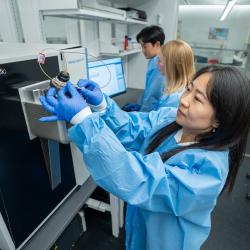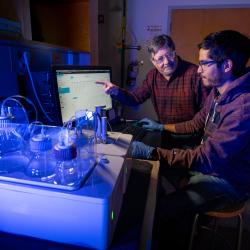UMD Scientists Create Chemical Compound That Can Reverse Effects of Potentially Deadly Drugs
Their method successfully counteracted two highly addictive drugs—fentanyl and methamphetamine—in lab experiments
Drug overdoses in the United States have risen sharply in the last two decades. Nearly 92,000 people died from overdoses of illegal drugs and prescription opioids in 2020—more than five times the number of deaths in the year 2000—and synthetic opioids like fentanyl are one of the main culprits.
Naloxone (an injectable medicine also marketed as the nasal spray Narcan) has saved countless lives, but it only works for opioid overdoses and has other limitations. Now, in an effort to identify a more universal treatment for drug overdose, a team of University of Maryland scientists tested a chemical compound—Pillar[6]MaxQ (P6AS)—as an antidote for methamphetamine and fentanyl. Their findings, published today in the journal Chem, were highly promising.
“Opioids already have a reversal agent in naloxone, but there are a variety of non-opioid drugs of abuse—like methamphetamine, PCP, mephedrone, ecstasy (MDMA) and cocaine—that do not have a specific antidote,” said the study’s lead author Lyle Isaacs, a professor in the Department of Chemistry and Biochemistry at UMD. “That’s one of the huge opportunities for our compound.”
In vitro and in vivo laboratory tests showed that P6AS successfully sequestered fentanyl and methamphetamine, a non-opioid stimulant, and mitigated their potentially deadly biological effects. Additional in vitro tests revealed that P6AS also binds strongly to other drugs, including PCP, ecstasy and mephedrone, which suggests that P6AS could someday be used to counteract a wide array of drugs.
The study was conducted by Isaacs’ lab in collaboration with researchers in UMD’s Department of Cell Biology and Molecular Genetics and Department of Psychology. Although the synthesis and chemical properties of P6AS were first documented in 2020 by Isaacs and Weijian Xue, a former post-doctoral associate in the Department of Chemistry and Biochemistry, this study reports its first in vivo applications.
P6AS works as a molecular container, which means that it binds and sequesters other compounds in its central cavity.
“When we put molecules into our containers, we can turn off their biological properties and thereby reverse any effects that they might have,” Isaacs explained. “We’ve measured the interaction between our container and a variety of drugs of abuse—things like methamphetamine, fentanyl, ecstasy, PCP and others—and we find that this new container that we’ve made binds many of them very strongly.”
Lyle Isaacs explains how the P6AS molecular container compound works. Video by Chad Smith/Division of Research/UMD.
In vivo tests revealed that the effects of methamphetamine could be reversed by administering P6AS five minutes later, which is “still a little bit short for real-world situations,” Isaacs explained. The effects of fentanyl, however, could be reversed by administering P6AS up to 15 minutes later, which comes closer to meeting the federal guidelines for drug reversal agents.
Unlike naloxone, which stops a drug of abuse from binding to receptors in the brain, the UMD team’s molecular container targets drugs directly in the bloodstream.
“Our compound soaks up the drug in the bloodstream and, we believe, helps promote its excretion in the urine,” Isaacs said. “This is known as a pharmacokinetic process, where we’re trying to minimize the concentration of free drug that’s present in the body.”
Whether this compound helps promote a drug’s excretion from the body must be tested experimentally. If it performs in the way that researchers think it will, it could be particularly useful for overdoses of fentanyl, which is up to 50 times stronger than heroin and up to 100 times stronger than morphine. Its potency and lingering effects in the body explain why some patients continue to overdose even after receiving naloxone. Isaacs believes that the excretion of fentanyl could help prevent this phenomenon, known as renarcotization.
Isaacs said it will likely be years before the new compound is approved for human use. However, he envisions that it could be delivered as an injection, much like naloxone but potentially with broader applications. Isaacs believes it could even be used to treat overdoses of extremely powerful drugs like carfentanil, which has been linked to a string of overdose deaths in recent years.
“There are other synthetic opioids that are much stronger than fentanyl—things like carfentanil, which are difficult to reverse using naloxone,” Isaacs said. “In addition, people are getting so much fentanyl that multiple doses of naloxone are needed, so there’s room for a new and improved agent that might help in those situations.”
###
In addition to Isaacs and Xue, co-authors of this study from UMD included Psychology Assistant Research Professor Adam Brockett and Professor Matthew Roesch, Cell Biology & Molecular Genetics Professor Volker Briken and Assistant Research Scientist Shivangi Rastogi, Chemistry and Biochemistry former postdoctoral fellows Chun-Lin Deng and Canjia Zhai, biological sciences Ph.D. student Michael Shuster and chemistry Ph.D. student David King.
Their paper, “Pillar[6]MaxQ: A Potent Supramolecular Host for In Vivo Sequestration of Methamphetamine and Fentanyl,” was published in Chem on December 15, 2022.
This research was supported by the National Institutes of Health (Award Nos. GM132345, T32 GM08021 and T32 AI089621). This story does not necessarily reflect the views of this organization.






